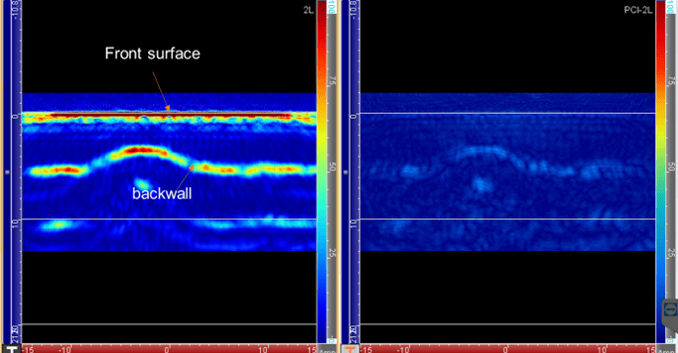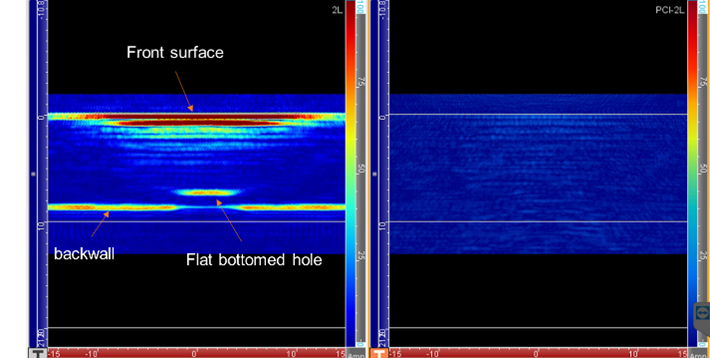How to calculate a PCI image
Here we’ll explain how to calculate a Total Focusing Method (TFM) image first. The FMC/TFM is an inspection technique that involves two steps. The first is the data acquisition process called FMC, and the second is data reconstruction: TFM. The whole process is typically done in real time on most hardware, so the two steps are transparent to users.
The FMC is a matrix consisting of the combination of N transmitted signals and N received signals with each matrix cell containing an A-scan time domain signal. It is obtained by firing the N elements of the Phased Array Ultrasonic Testing (PAUT) probe one by one and recording on all receivers each time.
The TFM algorithm consists of coherently summing amplitudes from the signals of the FMC dataset to focus at every pixel of a Region of Interest (ROI). Mathematically, this can be expressed as:
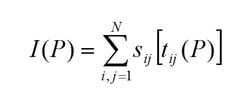
where tij(P) denotes the theoretical time-of-flight corresponding to the propagation time between the emitter Ei and receiver Rj, through one of the pixels P.
The following figure explains the process for one pixel and one signal of the FMC.
-
The TFM process calculates the time-of-flight tij to go from emitter Ei to pixel P and back to receive Rj. The amplitude Aij corresponding to that time-of-flight is then extracted for that particular signal.
-
The process is then repeated for all the signals of the FMC matrix.
-
All these amplitudes are summed, and the result is the amplitude for that pixel in the TFM image.
-
The entire process is then repeated for all the pixels to obtain the TFM image.
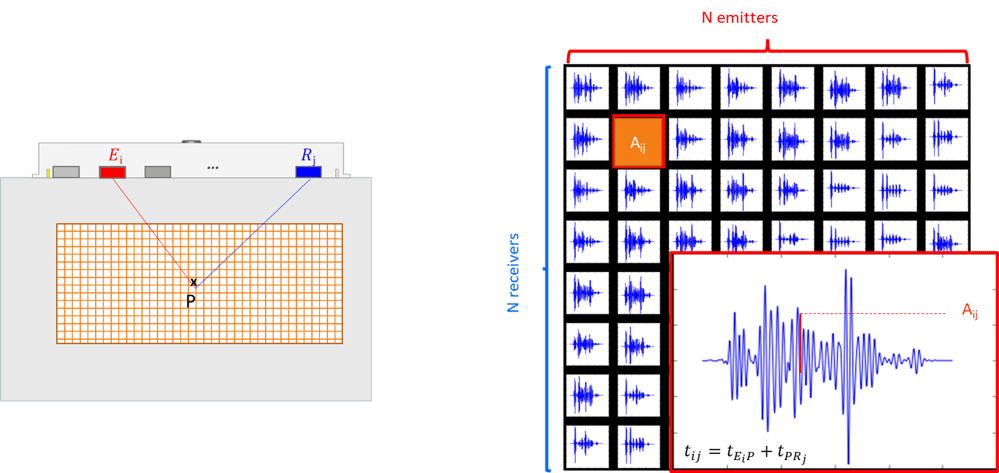
To calculate the PCI image, we need to transform the A-scan signals of the FMC into phase versus time. The phase can be obtained by dividing the signals by the modulus of their Hilbert transform (analytical signal). An alternative is to extract the sign of the FMC signals. It provides similar results as calculating the true phase and has a simpler implementation on the hardware. Each signal of the FMC matrix is replaced by its sign function so each data point is either a 1 or -1.

The process for calculating the PCI image is then similar to the TFM one. We calculate the time-of-flight tij to go from emitter Ei to pixel P and back to receive Rj. The phase Øij corresponding to that time-of-flight is then extracted for that particular signal. The process is then repeated for all the signals (transformed into their sign version) of the FMC matrix. All these phases are summed and the result is the phase for that pixel in the PCI image. The entire process is then repeated for all the pixels to obtain the PCI image.
PCI intensity explanation
If we compare the PCI image obtained on a mockup containing three side-drilled holes (SDH) to the TFM one, we can observe that:
-
PCI pretty much removes the front surface and backwall echoes,
-
The PCI value for the three SDH is identical,
-
The noise level in the PCI image is higher.

Why do we obtain high values for the SDH and low values for the geometry echoes? First let’s look at the pixel located at the maximum of the first SDH. In the image on the left, we display the first column of the FMC matrix, i.e., the 64 received signals after firing the first element. On top of that we superimpose the times-of-flight (red crosses) to go from emitter one to the SDH back to all the receivers. We can see that the red crosses superimpose perfectly for the same phase on all receivers, meaning that all the signals are in phase. By summing all these contributions, we obtain a high PCI value.
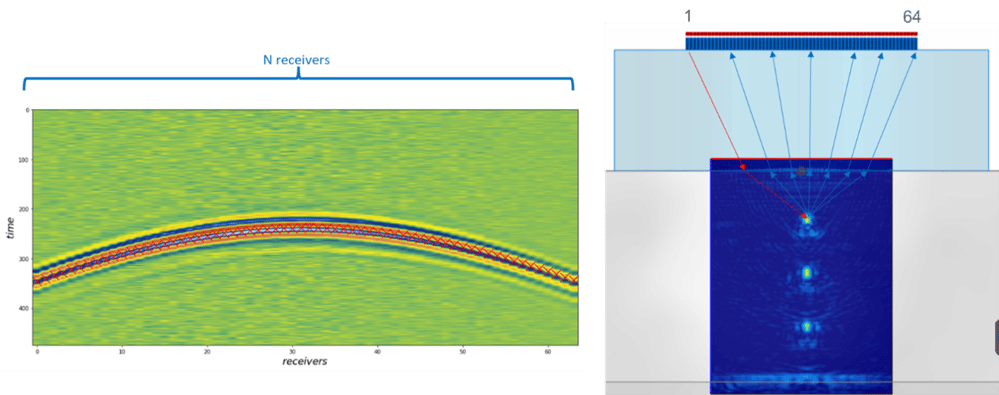
With the same reasoning for the pixel located in the middle of the backwall, we display the B-scan obtained after firing the first element and the times-of-flight to go from emitter one to the middle of the backwall back to all receivers (red crosses). Looking at the red crosses, we can see that they are superimposed with the same phase only for the last receivers (indicated by the red rectangle).
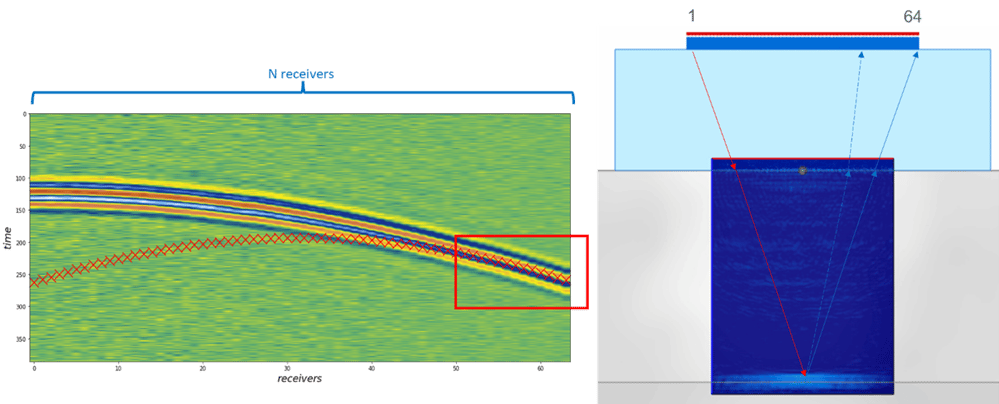
When dealing with geometry echoes such as front surface and backwall, mostly the symmetric paths contribute to the PCI image. All the other paths lead to an incoherent sum, which explain the low values of the PCI image along the backwall and front surface echo. This can be the same for other specular reflectors like delamination or lack of fusion depending on their position with respect to the probe.
When dealing with amplitude signals, the Signal-to-Noise Ratio (SNR) can be relatively high depending on the nature of the indications (backwall, LOF, etc.). The more energy we send into the part, by increasing the voltage of the analog gain for example, the better the SNR is for a TFM image. For phase signals, the noise varies between -1 and 1 like the phase of indications even if more energy is sent into the part. If we consider a gaussian noise with a zero mean, the more emitter-receiver pairs, the higher the SNR. It is thus recommended to use more sources (for example, full FMC versus sparse FMC).
It is theoretically possible to estimate the SNR of a PCI image as the noise is the sum of -1 and 1. It can be described by a Binomial distribution with equal probability of 1 and -1.
Looking at a PCI image with 500 kpixels, we can look at the distribution of noise levels for the entire PCI image for a full FMC (4096 signals) and sparse FMC (1024 signals) using the binomial distribution. There is pretty much no noise above 6% for the FMC and 11% for the sparse with 16 emissions. That doesn’t mean that it is not possible to have noise higher than that but it is very unlikely. These values can be used by operators to set the lower threshold of their dynamic range.
![]()
Results obtained for normal incidence inspections
In our first example, we look at a 25-millimeter-thick mockup with a notch along the backwall. We are using a 64L5-G3 probe with a 20-millimeter (0.787-inch) L0 wedge. We calculate at the same time the TFM and PCI images displayed below. We can see some artifacts in the TFM image called isochrones. When we calculate the times-of-flight to go to pixels covered by those artifacts, some of the TOF in the FMC matrix corresponds to contributions from the backwall; so, when we sum those contributions, we obtain some signal. The presence of those artifacts depends on the thickness of the part and the pitch. Looking at the PCI image, we see that those artifacts are gone as they are contributions from the backwall, and PCI tends to remove geometry echoes. We can see the tip of the notch very clearly, allowing perfect detection and sizing.
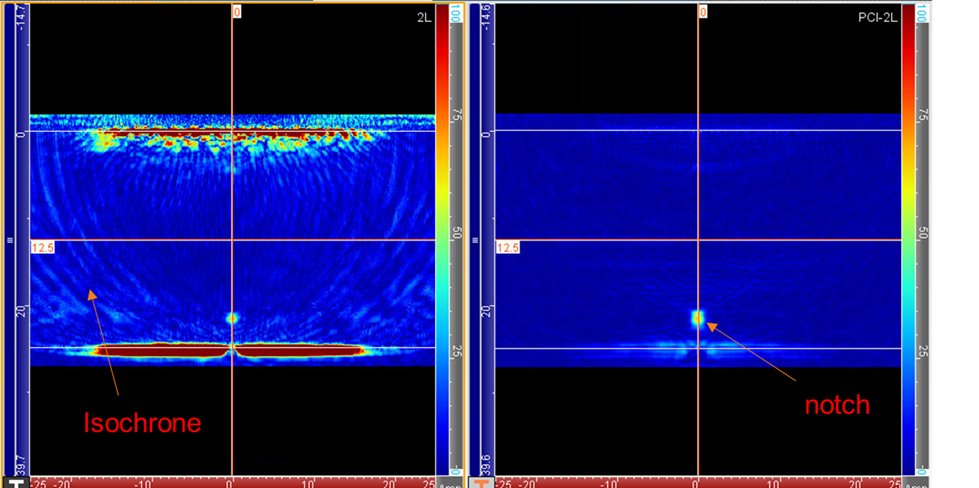
PCI is very efficient at seeing defects close to the backwall. We can see in the following figure on the left three SDH close to the backwall for TFM and PCI. PCI detects them while removing the backwall, which would allow detection much closer to it. It is not necessarily better than TFM when it comes to defects close to the front surface despite removing the front surface echo. If we look at the image on the right, we can distinguish two of the SDH in the TFM image, the other one being in the dead zone. For PCI, we see the deepest SDH and distinguish the middle one. This is due to the fact that a lot of the emitter-receiver pairs far from the defect don’t contribute in phase.

A perfect application for PCI is the inspection of High Temperature Hydrogen Attack (HTHA). HTHA damage usually displays small cracks that send energy in all directions. Eddyfi Technologies developed a 64-element, 10-MHz probe that focuses along the passive plane to improve sensitivity as cracks are small in both directions. The sample that we looked at has micro-cracks ranging from a few microns to less than 100 microns. The following image shows the TFM with its C-scan on the left and the PCI on the right. The TFM image shows the same artifacts as we have seen before preventing the detection of the very tiny microcracks. The PCI image removes the artifacts and shows tiny responses along the backwall corresponding to the HTHA damage. Looking at the C-scan, we can clearly see the cloud of HTHA, which is not visible on the TFM image.
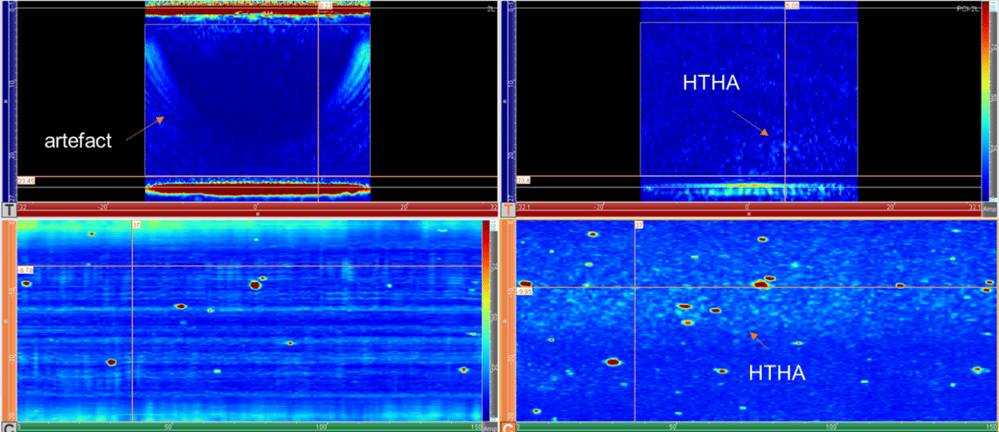
FMC
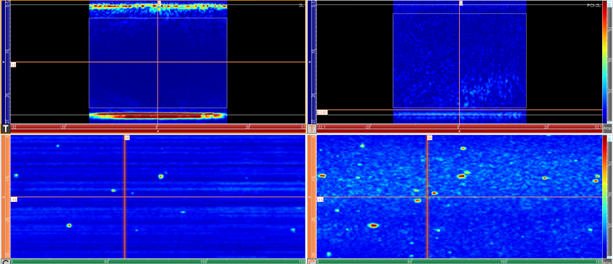
PWI
One drawback of PCI is the need to use a full FMC to obtain a good SNR. This usually has an impact on productivity. We have implemented Plane Wave Imaging (PWI) in the past to improve scanning speed for TFM inspections. We have applied PWI combined with PCI using 16 angles ranging from -20 to 20° to the same HTHA mockup, and we obtained the same results despite the fact that we used four times less sources. In theory, our noise level should have pretty much doubled. What’s happening here is that some of the FMC A-scans didn’t have enough energy as the defects are really tiny, and their SNR was zero. It is not possible to extract a phase when there is no signal. PWI allowed for sending more energy into the part and obtaining sufficient energy to extract a phase compensating for the increased noise due to the fact that we only used 16 sources. This allows increasing the scanning speed by a factor close to four.
We also looked at corrosion mapping and composite inspection, both of which are usually performed with a normal incidence inspection. We compare it to TFM using the same probe described before. For corrosion, TFM shows the front surface echo and the backwall allowing measurement of the remaining wall thickness. As PCI removes the front surface and backwall echoes and doesn’t have good detectability close to the front surface, it is not the best technique for corrosion mapping. We can distinguish a little bit the backwall with PCI, but it mostly shows areas where there is changes of slope as diffraction echoes. The front surface is completely gone.
It is similar for composite inspection for which the front surface and backwall echoes disappear entirely as well as the Flat-Bottomed Hole (FBH). In composite material inspection, it is difficult for the ultrasound to propagate at an angle as the plies steer the energy either perpendicularly or along the plies. For PCI, mostly the symmetric paths contribute, i.e., the ones with the most angle. This explains why the backwall and FBH are completely gone.
|
Corrosion mapping |
Composite inspection |
Results obtained for angled beam inspections
We looked at applying PCI to weld inspection. We inspected a carbon steel pipe containing seven defects. The solution-based manual UT scanner is in its weld inspection configuration. We used two 64L5-G3 probes with SW55 wedge.
We performed multiple inspections in a multigroup configuration comparing TFM to PCI using a full FMC, sparse FMC and PWI.
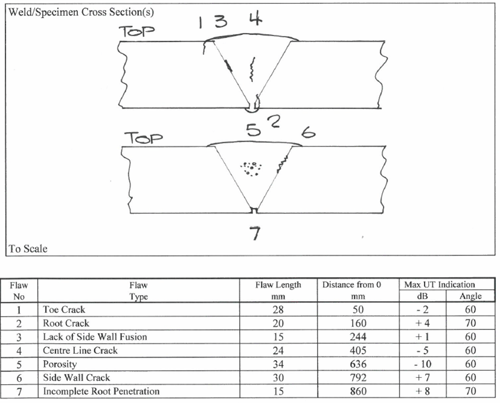
In the following figures, we display the various defects obtained with PCI on each side of the probe, no TFM here, for all the defects. The dynamic range is adjusted between 6%, which is the theoretical value for the noise when using a full FMC, and 30% to increase the visualization of the weaker PCI values.
Volumetric defects like porosities are easily detected with an SNR of 19 dB. The root and toe crack are detected from both sides and lead to tip diffraction for characterization. Some discrepancies appear in terms of sizing when comparing from both sides. This could be caused by rebound off the root of the weld. In the same way, we can see that the lack of fusion and the sidewall crack leads to tip diffraction echoes from both sides. Sizing again shows some discrepancies when looking from both sides. This suggests that inspection from both sides is mandatory to perform accurate sizing.



When performing PCI inspection with multiple groups and a full FMC, the major difficulty is the scanning speed. We evaluated the possibility of using PWI with PCI for the inspection of this weld using only eight angles, which provides an improvement in scanning speed by a factor of eight.
The following shows the LOF obtained with a full FMC (left) and PWI (right). The SNR drops from 22 dB for FMC to 12 dB with PWI. While this is still sufficient to detect tip diffraction echoes and perform sizing in this case, that might not always be the case. It is up to operators to evaluate the necessary number of angles to obtain sufficient SNR on a calibration block containing artificial defects.
%20and%20PWI%20(right).png?width=999&height=259&name=LOF%20obtained%20with%20a%20full%20FMC%20(left)%20and%20PWI%20(right).png)
Warning
We looked at another sample containing a LOF and performed an inspection using TFM and PCI. The TFM image shows a specular reflection, and sizing is possible with a decibel drop. We would expect PCI to show two tip diffractions but it shows only one echo. As it is a non-amplitude-based imaging technique, a decibel drop cannot be used, and the defect cannot be sized. This effect can happen if the LOF is relatively smooth and the probe is positioned in such a way that the angle hitting the bevel perpendicularly (for example, 60° here) hits the defect in the middle. For this position, the LOF acts like geometry echoes with symmetric paths contributing in the middle of the defect.
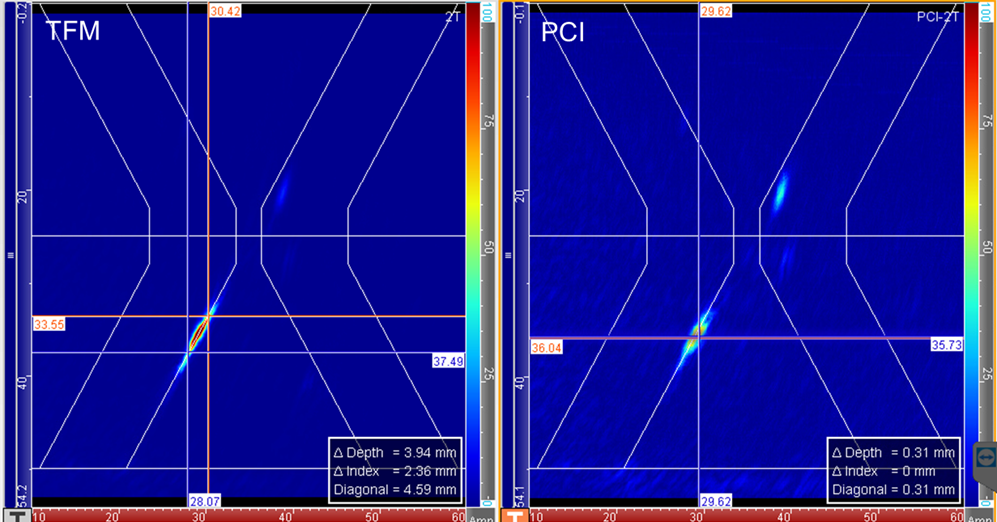
The other discrepancy observed is the difference in sizing when performed on the first and second legs. For example, in the following image we size a LOF using tip diffraction echoes on the first (right) and second (left) legs by positioning cursors along the tip diffraction. We measure a defect height of 5 and 3.9 millimeters (0.197 and 0.154 inches), respectively. The difference could be due to a backwall that is not perfectly parallel to the front surface, UT beam effects, etc. More investigation is required to determine the origin of this discrepancy.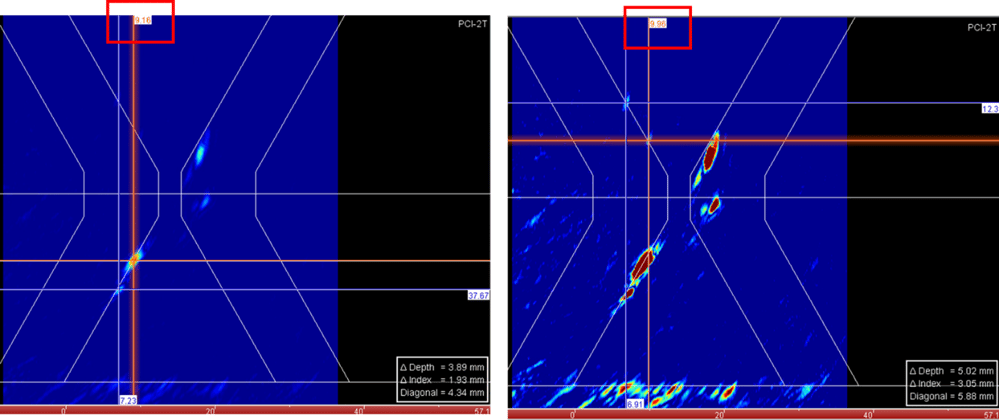
Pros and cons of Phase Coherence Imaging
Pros of the technique:
-
PCI is a complementary technique that provides better sizing capabilities for lack of fusion and cracks along the fusion face as tip diffraction echoes are better resolved.
-
Phase coherence imaging provides better visualization of porosities without having to increase the gain.
-
PCI is less sensitive to orientation along the passive plane.
-
As phase coherence imaging removes artifacts coming from geometries, it is better for the detection of small defects close to the backwall when performing L0 inspection, such as HTHA.
-
As a sizing method, PCI doesn’t require calibration as it is based on tip diffraction measurement.
Cons:
-
As SNR depends on the number of emitter-receiver pairs, it is recommended to use a full FMC; this leads to a drop in scanning speed especially when performing an inspection from both sides of the weld. PWI can be used, but the number of angles has to be adjusted to obtain decent SNR.
-
It is possible for some smooth defects such as LOF to not display tip diffraction and thus sizing is not possible for those cases, and it may then be necessary to change the index offset until tip diffraction appears.
-
As it removes geometry echoes, PCI is not suited for corrosion mapping nor composite inspection.
-
Defects close to the front surface are not detected very well.
Eddyfi Technologies will propose the PCI technique for the Mantis™ and Cypher® portable phased array instruments. It will be possible to use multigroup configurations to simultaneously perform TFM and PCI and combine it with PWI for faster acquisitions. This will allow users to tackle all kinds of applications and evaluate the technology for their own applications.
Take a closer look at easily the most advanced portable PAUT instrument here.
Did you know we offer courses on our advanced PAUT and TFM inspection solutions? Check out the Eddyfi Academy to stay Beyond Current! And for access to instant pricing, head over to the Eddyfi eStore or contact our experts today.
References:
-
Camacho, M. Parrilla, C. Fritsch, “Phase Coherence Imaging”, IEEE Trans. Ultrason. Ferroelectr. Freq. Control, 56, 5, pp. 958-974, 2009
-
Camacho, D. Atehortua, JF Cruza, J. Brizuela, K. Ealo, “Ultrasonic crack evaluation by phase coherence processing and TFM and its application to online monitoring in fatigue tests”, NDT & E International, Volume 93, Pages 164-174, 2018
-
Lesage, M. Marvasti and O. Farla, “Phase coherence total focusing method for enhancement of small omni-directional scatterers and suppression of geometric reflectors: Application to near-surface crack sizing and detection of high temperature hydrogen attack”, NDT & E International, Volume 123, 2021
-
Dupont-Marillia, J; W. Krynicki, P. Belanger, “Early detection of high temperature hydrogen attack using the ultrasonic full matrix capture and advanced post-processing methods”, NDT&E International 130 (2022)





